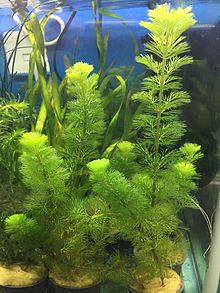Vegetative characteristics
Cabomba aquatica is a rhizomatous, [2] perennial, [3] aquatic herb [4] with green to red, [6] up to 1.5 m long stems. [7] [8] [9] Both submerged and floating leaves are produced. [10] The finely divided, [3] reniform, 4–5 cm long, and 6 cm wide submerged leaves are trichotomously branched. [11] The orbicular to broadly elliptic floating leaves, [12] which are produced towards the apex of the shoot, [8] with an entire margin are 5–20 mm long, and 4–15 mm wide. [13] The petiole is 9.0–55.0 mm long. [14]
Generative characteristics
The golden yellow, solitary, bisexual, [3] diurnal, incompletely protogynous, nectariferous, [15] 0.5–1.1 cm wide flower [6] extends beyond the water surface. [16] [10] It has 3(–4) 3.7–3.8 mm long, and 1.4–2.1 mm wide sepals. [14] The androecium consists of (3–)6 [6] bright yellow stamens [13] with 2.5–4 mm long filaments. [6] The very large, elongate, monosulcate pollen grains are 71.8–88.3 µm long, and 38.9–48.4 µm wide. [17] The gynoecium consists of 2–3(–4) carpels. [6] Each fruit bears a single oval, [12] black, [13] 2–3.5 mm long, and 1.5–2.5 mm wide seed. [18] [13] The fruit develops underwater. [10]



